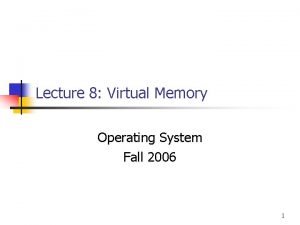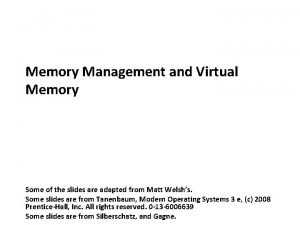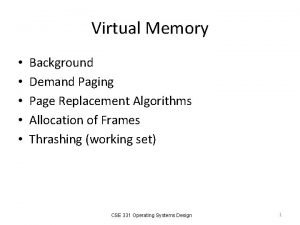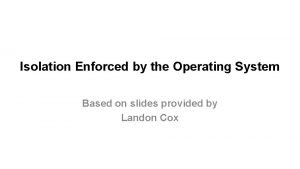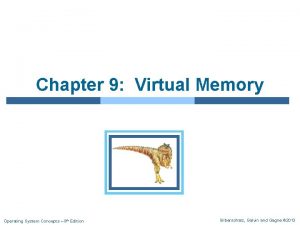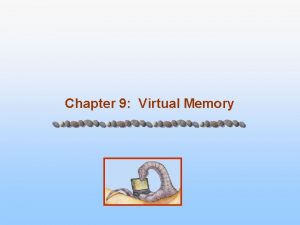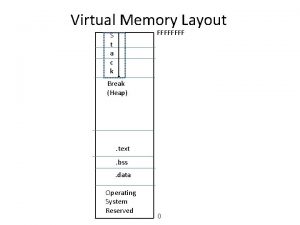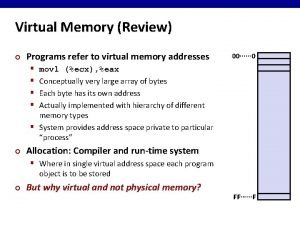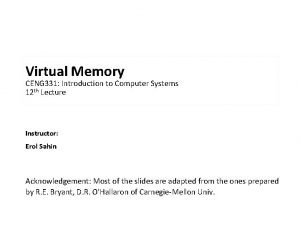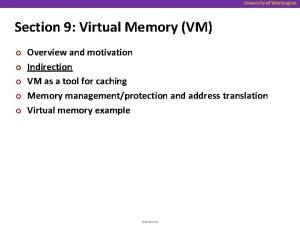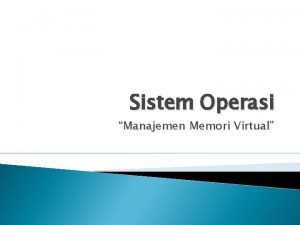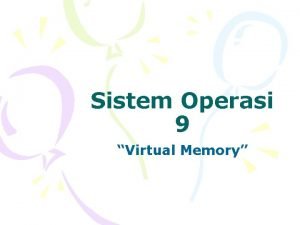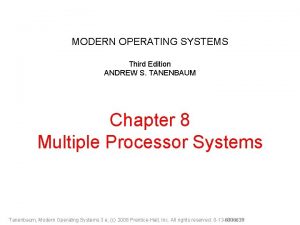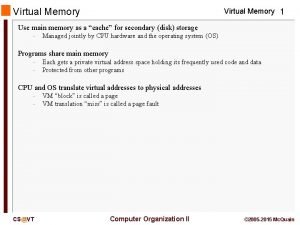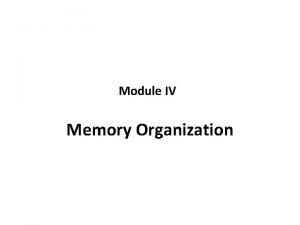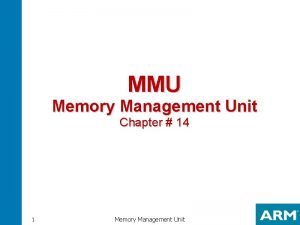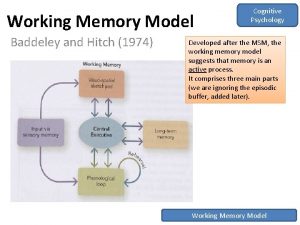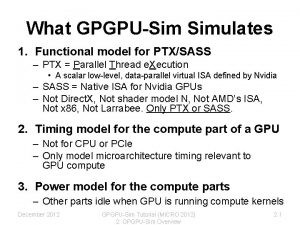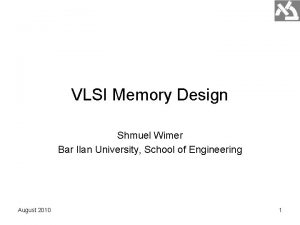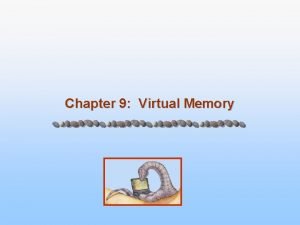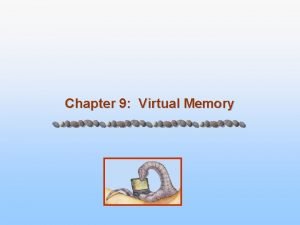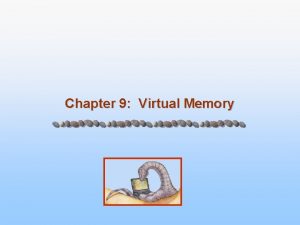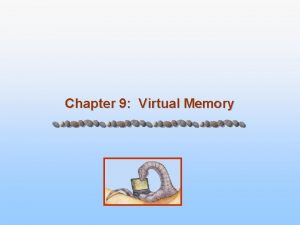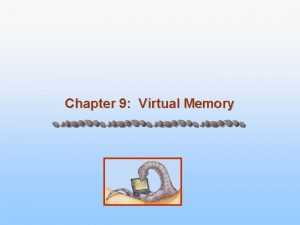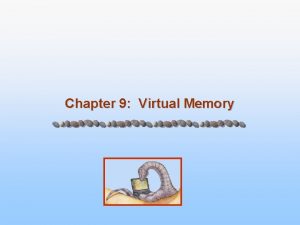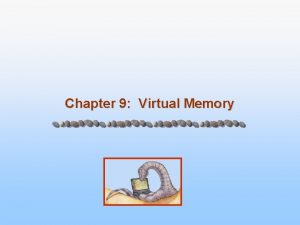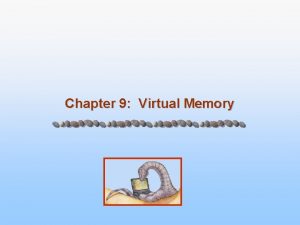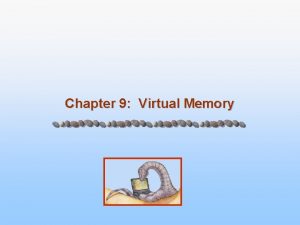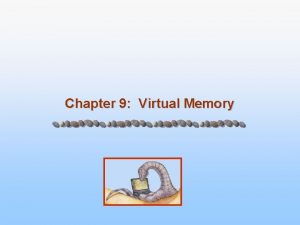Chapter 10 Virtual Memory Chapter 10 Virtual Memory





































































![Other Issues – Program Structure n Program structure l int[128, 128] data; Each row Other Issues – Program Structure n Program structure l int[128, 128] data; Each row](https://slidetodoc.com/presentation_image_h/1c58ff5da83f79f84c291b3baffea561/image-70.jpg)

- Slides: 71

Chapter 10: Virtual Memory

Chapter 10: Virtual Memory n Background n Demand Paging n Copy-on-Write n Page Replacement n Allocation of Frames n Thrashing n Memory-Mapped Files n Allocating Kernel Memory n Other Considerations 2

Objectives n To describe the benefits of a virtual memory system n To explain the concepts of demand paging, page-replacement algorithms, and allocation of page frames n To discuss the principle of the working-set model n To examine the relationship between shared memory and memory-mapped files n To explore how kernel memory is managed 3

Background n Code needs to be in memory to execute, but entire program rarely used n Entire program code not needed at same time n Consider ability to execute partially-loaded program l Program no longer constrained by limits of physical memory l Each program takes less memory while running -> more programs run at the same time 4 Increased CPU utilization and throughput with no increase in response time or turnaround time l Less I/O needed to load or swap programs into memory -> each user program runs faster 4

Background (Cont. ) n Virtual memory – separation of user logical memory from physical memory l Only part of the program needs to be in memory for execution l Logical address space can therefore be much larger than physical address space l Allows address spaces to be shared by several processes l Allows for more efficient process creation l More programs running concurrently l Less I/O needed to load or swap processes 5

Background (Cont. ) n Virtual address space – logical view of how process is stored in memory l Usually start at address 0, contiguous addresses until end of space l Meanwhile, physical memory organized in page frames l MMU must map logical to physical n Virtual memory can be implemented via: l Demand paging l Demand segmentation 6

Virtual Memory That is Larger Than Physical Memory n Virtual memory involves the separation of logical memory as perceived by users from physical memory. n This separation allows an extremely large virtual memory to be provided for programmers when only a smaller physical memory is available 7

Virtual-address Space n Usually design logical address space for stack to start at Max logical address and grow “down” while heap grows “up” l Maximizes address space use l Unused address space between the two is hole 4 No physical memory needed until heap or stack grows to a given new page n VA(Virtual Address) space enables sparse address spaces with holes left for growth, dynamically linked libraries, etc n System libraries shared via mapping into virtual address space 8

Shared Library Using Virtual Memory n System libraries can be shared by several processes through mapping of the shared object into a virtual address space. • Although each process considers the libraries to be part of its virtual address space, the actual pages where the libraries reside in physical memory are shared by all the processes n Pages can be shared during process creation with the fork() system call, thus speeding up process creation. 9

Demand Paging n Could bring entire process into memory at load time n Or bring a page into memory only when it is needed Demand paging ! Less I/O needed l Less memory needed l Faster response l More users n Similar to paging system with swapping (diagram on right) n Page is needed reference to it l invalid reference abort l not-in-memory bring to memory n Lazy swapper – swaps a page into memory when page will be needed l Swapper that deals with pages is a pager l 10

Basic Concepts n When a process is to be swapped in, the pager guesses which pages will be used before the process is swapped out again n Instead of swapping in a whole process, the pager brings only those pages into memory l 사용되지 않을 페이지는 메모리로 가져오지 않음으로서 시간 낭비와 메모 리 공간 낭비를 줄일 수 있음 n How to determine that set of pages? l Need new MMU functionality to implement demand paging n If pages needed are already memory resident l No difference from non demand-paging n If page needed and not memory resident l Need to detect and load the page into memory from storage 4 Without changing program behavior 4 Without programmer needing to change code 11

Valid-Invalid Bit n With each page table entry a valid–invalid bit is associated (v in-memory – memory resident, i not-in-memory) n Initially valid–invalid bit is set to i on all entries n Example of a page table snapshot: n During MMU address translation, if valid–invalid bit in page table entry is i page fault 12

Page Table When Some Pages Are Not in Main Memory Page table의 valid/invalid bit에서 v는 해당 페이지가 main memory에 있다는 의미 프로세스가 main memory에 없는 페이지를 접근하려고 하면 page fault trap이 발생함 13

Page Fault n If there is a reference to a page, first reference to that page will 1. 2. 3. 4. 5. trap to operating system: page fault Operating system looks at another table to decide: l Invalid reference abort l Just not in memory Find free frame Swap page into frame via scheduled disk operation Reset tables to indicate page now in memory Set validation bit = v Restart the instruction that caused the page fault 14

Steps in Handling a Page Fault § If there is a reference to a page, first reference to that page will trap to operating system: page fault. < the procedure for handling this page fault> Ø We check internal table for this process to determine whether the reference was a valid or an invalid memory access Ø If the reference was invalid, we terminate the process. If it was valid but we have not yet brought in that page, we now page it in. Ø We find a free frame Ø We schedule a disk operation to read the desired page into the newly allocated frame Ø When the disk read is complete, we modify the internal table kept with the process and the page table to indicate that the page is now in memory Ø We restart the instruction that was interrupted by the trap. The process can now access the page as though it had always been in memory 15

Aspects of Demand Paging n Extreme case – start process with no pages in memory l OS sets instruction pointer to first instruction of process, non-memory-resident page fault l And for every other process pages on first access l Pure demand paging (즉, 어떤 페이지가 필요해지기 전에는 결코 그 페이지를 메모리로 적재하지 않음) n Actually, a given instruction could access multiple pages multiple page faults l Consider fetch and decode of an instruction which adds 2 numbers from memory and stores result back to memory l 즉, 이론적으로는 하나의 명령어에서도 여러 번 page fault 생길 수 있음 성능 저하 발생 4 다행스럽게도 많이 발생하지는 않음(locality of reference 때문) n Hardware support needed for demand paging l Page table with valid / invalid bit l Secondary memory (swap device with swap space) l Instruction restart 16

Performance of Demand Paging n Demand Paging can significantly affect the performance of a computer system l To see why, let’s compute the effective access time for a demand-paged memory. l For most computer systems, the memory-access time, denoted ma, ranges from 10 to 200 nanoseconds. 4 As long as we have no page faults, the effective access time is equal to the memory access time. 4 If, however, a page fault occurs, we must first read the relevant page from disk and then access the desired word. l Let p be the probability of a page fault (0 ≤ p ≤ 1). We would expect p to be close to zero—that is, we would expect to have only a few page faults. l The effective access time is then 17

Performance of Demand Paging n Stages in Demand Paging (worst case) 1. Trap to the operating system 2. Save the user registers and process state 3. Determine that the interrupt was a page fault Page fault Interrupt 발생 확인 4. Check that the page reference was legal and determine the location of the page on the disk 5. Issue a read from the disk to a free frame (memory): 1. Wait in a queue for this device until the read request is serviced 2. Wait for the device seek and/or latency time 3. Begin the transfer of the page to a free frame 6. While waiting, allocate the CPU to some other user Disk 읽기 main memory로 page 이동 (Disk, I/O read시, wait 될 수 있 음) 7. Receive an interrupt from the disk I/O subsystem (I/O completed) 8. Save the registers and process state for the other user Disk 읽기가 Interrupt로 처리됨 9. Determine that the interrupt was from the disk 10. Correct the page table and other tables to show page is now in memory 11. Wait for the CPU to be allocated to this process again 12. Restore the user registers, process state, and new page table, and then resume the interrupted instruction 프로세스 재시작 18

Performance of Demand Paging (Cont. ) n A page fault causes the following 3 major activities l Service the interrupt – careful coding means just several hundred instructions needed l Read the page – lots of time l Restart the process – again just a small amount of time n Page Fault Rate 0 p 1 l if p = 0 no page faults l if p = 1, every reference is a fault n Effective Access Time (EAT) EAT = (1 – p) x memory access + p (page fault overhead + swap page out + swap page in ) 19

Demand Paging Example n Memory access time = 200 nanoseconds n Average page-fault service time = 8 milliseconds n EAT = (1 – p) x 200 + p x (8 milliseconds) = (1 – p x 200 + p x 8, 000 = 200 + p x 7, 999, 800 n If one access out of 1, 000 causes a page fault (i. e, p=1/1, 000), then EAT = 8. 2 microseconds. This is a slowdown by a factor of 40!! (200 ns Memory access time보다 약 40배 느려짐) n If you want to keep the performance degradation due to paging less than 10 percent, we should allow fewer than one page-fault (memory access) out of 400, 000 memory accesses l 220 > 200 + 7, 999, 800 x p 20 > 7, 999, 800 x p l p <. 0000025 l < one page fault in every 400, 000 memory accesses 20

Demand Paging Optimizations n Disk I/O to swap spaceis faster than that to the file system l Because swap space is allocated in much larger blocks, and file lookups and indirect allocation methods are not used n Can get better paging throughput by copying entire process(file) image into the swap space at process startup(load) time and then performing demand paging from the swap space l Used in older BSD Unix n Mobile systems l Typically don’t support swapping l 대신, 이러한 시스템에서는 파일 시스템에서 page를 요구함. 또한, 만약 memory 제 약 상황이 발생시, code와 같은 read-only page 부분이 memory로부터 방출됨 4 Update된 page는 수정된 데이터를 가지므로 page 방출시 동기화 등 여러 절차가 필요하므로 read-only page 부분을 memory로부터 없애는 것이 편함 21

Copy-on-Write 프로세스 1이 page C를 수정 한 후 (page C가 복사됨) 프로세스 1이 page C를 수정하기 전 n Fork() 수행시, parent process공간을 child process 에 처음부터 page를 복사하지 않고 child process가 해당 page에 write할때, page를 복사하는 기법 n Copy-on-Write (COW) allows both parent and child processes to initially share the same pages in memory l If either process modifies a shared page, only then is the page copied n COW allows more efficient process creation as only modified pages are copied n In general, free pages are allocated from a pool of zero-fill-on-demand pages l Pool should always have free frames for fast demand page execution n vfork() variation on fork() system call has parent suspended and child using copy-on- write address space of parent l Designed to have child call exec() l Very efficient 22

Page Replacement n Prevent over-allocation of memory by modifying page-fault service routine to include page replacement n Use modify (dirty) bit to reduce overhead of page transfers – only modified (updated) pages are written to disk l 즉, 특정 memory frame을 차지하는 page가 새로운 값으로 update되 지 않았다면 굳이 disk에 저장할 필요없음 (disk로의 page out/write 필요없음) 23

What Happens if There is no Free Frame? n Every memory used up (occupied) by process pages l Also in demand from the kernel, I/O buffers, etc l 즉, 메모리는 프로그램 페이지를 저장하는 용도뿐만 아니라, I/O 버퍼 용도로 도 사용하므로 어느정도의 메모리를 page에 할당하고 시스템 I/O용으로 사 용할지 결정해야함 n How much to allocate to each? l 과할당은 process가 실행 중, page fault 발생시, 과도한 overhead 유발 4 update된 기존 page out, 새로운 page를 paging in 두번의 Disk access 필요 n Page replacement – find some page in memory, but not really in use, page it out l Algorithm – terminate? swap out? replace the page? l Performance – want an algorithm which will result in minimum number of page faults n Same page may be brought into memory several times 24


Basic Page Replacement • 즉, empty memory frame이 없으면 현재 사용되고 있지 않는 frame을 찾아서 이를 비워야 함. 그 프레임의 내용을 disk swap 공간에 쓰고 그 페이지가 메모리에 존재 하지 않는다고 page table을 update함(v invalid) 1. Find the location of the desired page on disk 2. Find a free frame: - If there is a free frame, use it - If there is no free frame, use a page replacement algorithm to select a victim frame - Write victim frame to disk if dirty 3. Bring the desired page into the (newly) free frame; update the page and frame tables 4. Continue the process by restarting the instruction that caused the trap Note now potentially 2 page transfers for page fault – increasing EAT 26

Page Replacement 27

Page and Frame Replacement Algorithms n Frame-allocation algorithm determines l How many frames to give each process l Which frames to replace n Page-replacement algorithm l Want lowest page-fault rate on both first access and re-access n Evaluate algorithm by running it on a particular string of memory references (reference string) and computing the number of page faults on that string l String is just page numbers, not full addresses l Repeated access to the same page does not cause a page fault l Results depend on number of frames available n In all our examples, the reference string of referenced page numbers is 7, 0, 1, 2, 0, 3, 0, 4, 2, 3, 0, 3, 2, 1, 2, 0, 1, 7, 0, 1 28

Graph of Page Faults Versus The Number of Frames frame의 수가 많으면 page fault 횟수는 감소 29

First-In-First-Out (FIFO) Algorithm n Reference string: 7, 0, 1, 2, 0, 3, 0, 4, 2, 3, 0, 3, 2, 1, 2, 0, 1, 7, 0, 1 n 3 frames (3 pages can be in memory at a time per process) 15 page faults n Can vary by reference string: consider 1, 2, 3, 4, 1, 2, 5, 1, 2, 3, 4, 5 l Adding more frames can cause more page faults! 4 Belady’s Anomaly n How to track ages of pages? l Just use a FIFO queue 30

FIFO Illustrating Belady’s Anomaly 31

Optimal Algorithm n Replace page that will not be used for longest period of time l 9 is optimal for the example n How do you know this? l Can’t read the future n Used for measuring how well your algorithm performs 32

Least Recently Used (LRU) Algorithm n Use past knowledge rather than future n Replace page that has not been used in the most amount of time n Associate time of last use with each page n 12 faults – better than FIFO but worse than OPT n Generally good algorithm and frequently used n But how to implement? 33

LRU Algorithm (Cont. ) n Counter implementation l Every page entry has a counter; every time page is referenced through this entry, copy the clock into the counter l When a page needs to be changed, look at the counters to find smallest value 4 Search through table needed n Stack implementation l Keep a stack of page numbers in a double link form: l Page referenced: 4 move it to the top 4 requires 6 pointers to be changed l But each update more expensive l No search for replacement n LRU and OPT are cases of stack algorithms that don’t have Belady’s Anomaly 34

Use Of A Stack to Record Most Recent Page References 35

LRU Approximation Algorithms n LRU needs special hardware and still slow n Reference bit l With each page associate a bit, initially = 0 l When page is referenced bit set to 1 l Replace any with reference bit = 0 (if one exists) 4 We do not know the order, however n Second-chance algorithm l Generally FIFO, plus hardware-provided reference bit l Clock replacement l If page to be replaced has 4 Reference 4 reference bit = 0 -> replace it bit = 1 then: – set reference bit 0, leave page in memory – replace next page, subject to same rules 36

Second-Chance (clock) Page-Replacement Algorithm 37

Enhanced Second-Chance Algorithm n Improve algorithm by using reference bit and modify bit (if available) in concert n Take ordered pair (reference, modify) 1. (0, 0) neither recently used not modified – best page to replace 2. (0, 1) not recently used but modified – not quite as good, must write out before replacement 3. (1, 0) recently used but clean – probably will be used again soon 4. (1, 1) recently used and modified – probably will be used again soon and need to write out before replacement n When page replacement called for, use the clock scheme but use the four classes replace page in lowest non-empty class l Might need to search circular queue several times 38

Counting Algorithms n Keep a counter of the number of references that have been made to each page l Not common n Lease Frequently Used (LFU) Algorithm: replaces page with smallest count n Most Frequently Used (MFU) Algorithm: based on the argument that the page with the smallest count was probably just brought in and has yet to be used 39

Page-Buffering Algorithms n Keep a pool of free frames, always l Then frame available when needed, not found at fault time l Read page into free frame and select victim to evict and add to free pool l When convenient, evictim n Possibly, keep list of modified pages l When backing store otherwise idle, write pages there and set to non-dirty n Possibly, keep free frame contents intact and note what is in them l If referenced again before reused, no need to load contents again from disk l Generally useful to reduce penalty if wrong victim frame selected 40

Applications and Page Replacement n All of these algorithms have OS guessing about future page access n Some applications have better knowledge – i. e. databases n Memory intensive applications can cause double buffering l OS keeps copy of page in memory as I/O buffer l Application keeps page in memory for its own work n Operating system can given direct access to the disk, getting out of the way of the applications l Raw disk mode n Bypasses buffering, locking, etc 41

Allocation of Frames n Each process needs minimum number of frames n Example: IBM 370 – 6 pages to handle SS MOVE instruction: l instruction is 6 bytes, might span 2 pages l 2 pages to handle from l 2 pages to handle to n Maximum of course is total frames in the system n Two major allocation schemes l fixed allocation l priority allocation n Many variations 42

Fixed Allocation n Equal allocation – For example, if there are 100 frames (after allocating frames for the OS) and 5 processes, give each process 20 frames l Keep some as free frame buffer pool n Proportional allocation – Allocate according to the size of process l Dynamic as degree of multiprogramming, process sizes change 43

Priority Allocation n Use a proportional allocation scheme using priorities rather than size n If process Pi generates a page fault, l select for replacement one of its frames l select for replacement a frame from a process with lower priority number 44

Global vs. Local Allocation n Global replacement – process selects a replacement frame from the set of all frames; one process can take a frame from another l But then process execution time can vary greatly l But greater throughput so more common n Local replacement – each process selects from only its own set of allocated frames l More consistent per-process performance l But possibly underutilized memory 45

Non-Uniform Memory Access n So far all memory accessed equally n Many systems are NUMA – speed of access to memory varies l Consider system boards containing CPUs and memory, interconnected over a system bus n Optimal performance comes from allocating memory “close to” the CPU on which the thread is scheduled l And modifying the scheduler to schedule thread on the same system board when possible l Solved by Solaris by creating lgroups 4 Structure 4 Used to track CPU / Memory low latency groups my schedule and pager 4 When possible schedule all threads of a process and allocate all memory for that process within the lgroup 46

Thrashing n If a process does not have “enough” pages, the page-fault rate is very high l Page fault to get page l Replace existing frame l But quickly need replaced frame back l This leads to: 4 Low CPU utilization 4 Operating system thinking that it needs to increase the degree of multiprogramming 4 Another process added to the system n Thrashing a process is busy swapping pages in and out 47

Thrashing (Cont. ) 48

Demand Paging and Thrashing n Why does demand paging work? Locality model l Process migrates from one locality to another l Localities may overlap n Why does thrashing occur? size of locality > total memory size l Limit effects by using local or priority page replacement 49

Locality In A Memory-Reference Pattern 50

Working-Set Model n working-set window a fixed number of page references Example: 10, 000 instructions n WSSi (working set of Process Pi) = total number of pages referenced in the most recent (varies in time) l if too small will not encompass entire locality l if too large will encompass several localities l if = will encompass entire program n D = WSSi total demand frames l Approximation of locality n if D > m Thrashing n Policy if D > m, then suspend or swap out one of the processes 51

Keeping Track of the Working Set n Approximate with interval timer + a reference bit n Example: = 10, 000 l Timer interrupts after every 5000 time units l Keep in memory 2 bits for each page l Whenever a timer interrupts copy and sets the values of all reference bits to 0 l If one of the bits in memory = 1 page in working set n Why is this not completely accurate? n Improvement = 10 bits and interrupt every 1000 time units 52

Page-Fault Frequency n More direct approach than WSS n Establish “acceptable” page-fault frequency (PFF) rate and use local replacement policy l If actual rate too low, process loses frame l If actual rate too high, process gains frame 53

Working Sets and Page Fault Rates n Direct relationship between working set of a process and its page-fault rate n Working set changes over time n Peaks and valleys over time 54

Memory-Mapped Files n Memory-mapped file I/O allows file I/O to be treated as routine memory access by mapping a disk block to a page in memory n A file is initially read using demand paging l A page-sized portion of the file is read from the file system into a physical page l Subsequent reads/writes to/from the file are treated as ordinary memory accesses n Simplifies and speeds file access by driving file I/O through memory rather than read() and write() system calls n Also allows several processes to map the same file allowing the pages in memory to be shared n But when does written data make it to disk? l Periodically and / or at file close() time l For example, when the pager scans for dirty pages 55

Memory-Mapped File Technique for all I/O n Some OSes uses memory mapped files for standard I/O n Process can explicitly request memory mapping a file via mmap() system call l Now file mapped into process address space n For standard I/O (open(), read(), write(), close()), mmap anyway l But map file into kernel address space l Process still does read() and write() 4 Copies l data to and from kernel space and user space Uses efficient memory management subsystem 4 Avoids needing separate subsystem n COW can be used for read/write non-shared pages n Memory mapped files can be used for shared memory (although again via separate system calls) 56

Memory Mapped Files 57

Shared Memory via Memory-Mapped I/O 58

Shared Memory in Windows API n First create a file mapping for file to be mapped l Then establish a view of the mapped file in process’s virtual address space n Consider producer / consumer l Producer create shared-memory object using memory mapping features l Open file via Create. File(), returning a HANDLE l Create mapping via Create. File. Mapping() creating a named shared-memory object l Create view via Map. View. Of. File() n Sample code in Textbook 59

Allocating Kernel Memory n Treated differently from user memory n Often allocated from a free-memory pool l Kernel requests memory for structures of varying sizes l Some kernel memory needs to be contiguous 4 I. e. for device I/O 60

Buddy System n Allocates memory from fixed-size segment consisting of physically- contiguous pages n Memory allocated using power-of-2 allocator l Satisfies requests in units sized as power of 2 l Request rounded up to next highest power of 2 l When smaller allocation needed than is available, current chunk split into two buddies of next-lower power of 2 4 Continue until appropriate sized chunk available n For example, assume 256 KB chunk available, kernel requests 21 KB l Split into AL and AR of 128 KB each 4 One – further divided into BL and BR of 64 KB One further into CL and CR of 32 KB each – one used to satisfy request n Advantage – quickly coalesce unused chunks into larger chunk n Disadvantage - fragmentation 61

Buddy System Allocator 62

Slab Allocator n Alternate strategy n Slab is one or more physically contiguous pages n Cache consists of one or more slabs n Single cache for each unique kernel data structure l Each cache filled with objects – instantiations of the data structure n When cache created, filled with objects marked as free n When structures stored, objects marked as used n If slab is full of used objects, next object allocated from empty slab l If no empty slabs, new slab allocated n Benefits include no fragmentation, fast memory request satisfaction 63

Slab Allocation 64

Slab Allocator in Linux n For example process descriptor is of type struct task_struct n Approx 1. 7 KB of memory n New task -> allocate new struct from cache l Will use existing free struct task_struct n Slab can be in three possible states 1. Full – all used 2. Empty – all free 3. Partial – mix of free and used n Upon request, slab allocator 1. Uses free struct in partial slab 2. If none, takes one from empty slab 3. If no empty slab, create new empty 65

Slab Allocator in Linux (Cont. ) n Slab started in Solaris, now wide-spread for both kernel mode and user memory in various OSes n Linux 2. 2 had SLAB, now has both SLOB and SLUB allocators l SLOB for systems with limited memory 4 Simple List of Blocks – maintains 3 list objects for small, medium, large objects l SLUB is performance-optimized SLAB removes per-CPU queues, metadata stored in page structure 66

Other Considerations -- Prepaging n Prepaging l To reduce the large number of page faults that occurs at process startup l Prepage all or some of the pages a process will need, before they are referenced l But if prepaged pages are unused, I/O and memory wasted l Assume s pages are prepaged and α of the pages is used 4 Is cost of s * α save pages faults > or < than the cost of prepaging s * (1 - α) unnecessary pages? 4α near zero prepaging loses 67

Other Issues – Page Size n Sometimes OS designers have a choice l Especially if running on custom-built CPU n Page size selection must take into consideration: l Fragmentation l Page table size l Resolution l I/O overhead l Number of page faults l Locality l TLB size and effectiveness n Always power of 2, usually in the range 212 (4, 096 bytes) to 222 (4, 194, 304 bytes) n On average, growing over time 68

Other Issues – TLB Reach n TLB Reach - The amount of memory accessible from the TLB n TLB Reach = (TLB Size) X (Page Size) n Ideally, the working set of each process is stored in the TLB l Otherwise there is a high degree of page faults n Increase the Page Size l This may lead to an increase in fragmentation as not all applications require a large page size n Provide Multiple Page Sizes l This allows applications that require larger page sizes the opportunity to use them without an increase in fragmentation 69
![Other Issues Program Structure n Program structure l int128 128 data Each row Other Issues – Program Structure n Program structure l int[128, 128] data; Each row](https://slidetodoc.com/presentation_image_h/1c58ff5da83f79f84c291b3baffea561/image-70.jpg)
Other Issues – Program Structure n Program structure l int[128, 128] data; Each row is stored in one page l Program 1 for (j = 0; j <128; j++) for (i = 0; i < 128; i++) data[i, j] = 0; l 128 x 128 = 16, 384 page faults l Program 2 for (i = 0; i < 128; i++) for (j = 0; j < 128; j++) data[i, j] = 0; 128 page faults 70

Other Issues – I/O interlock n I/O Interlock – Pages must sometimes be locked into memory n Consider I/O - Pages that are used for copying a file from a device must be locked from being selected for eviction by a page replacement algorithm n Pinning of pages to lock into memory 71
 Virtual memory and cache memory
Virtual memory and cache memory Virtual memory in memory hierarchy consists of
Virtual memory in memory hierarchy consists of Prototype in semantics
Prototype in semantics Implicit memory
Implicit memory Long term memory vs short term memory
Long term memory vs short term memory Internal memory and external memory
Internal memory and external memory Primary memory and secondary memory
Primary memory and secondary memory Memory swaping
Memory swaping Which memory is the actual working memory?
Which memory is the actual working memory? Eidetic memory vs iconic memory
Eidetic memory vs iconic memory Shared memory vs distributed memory
Shared memory vs distributed memory Virtualmemory
Virtualmemory Virtual memory management techniques
Virtual memory management techniques Demand paging in virtual memory
Demand paging in virtual memory Memory management in os
Memory management in os Virtual memory advantages
Virtual memory advantages Explain virtual memory in computer architecture
Explain virtual memory in computer architecture Demand paging in virtual memory
Demand paging in virtual memory Virtual memory in os
Virtual memory in os Multilevel page tables
Multilevel page tables Virtual memory os
Virtual memory os Virtual memory
Virtual memory Virtual memory segmentation
Virtual memory segmentation Dram memory mapping
Dram memory mapping Virtual memory os
Virtual memory os Virtual memory os
Virtual memory os Virtual memory is commonly implemented by
Virtual memory is commonly implemented by Virtual memory
Virtual memory Virtual memory os
Virtual memory os Virtual memory
Virtual memory Virtual memory
Virtual memory Tlb
Tlb Virtual memory layout
Virtual memory layout Lokalitas dan memori virtual
Lokalitas dan memori virtual Virtual memory
Virtual memory Tlb computer architecture
Tlb computer architecture Virtual memory reddit
Virtual memory reddit Dram memory mapping
Dram memory mapping Virtual memory
Virtual memory Virtual memory
Virtual memory Virtual memory
Virtual memory G mail
G mail Karakteristik dari memori virtual
Karakteristik dari memori virtual Implementasi virtual memory
Implementasi virtual memory Shared virtual memory
Shared virtual memory Virtual memory
Virtual memory Memory paging
Memory paging What is virtual memory
What is virtual memory Virtual memory address translation
Virtual memory address translation Process virtual address space
Process virtual address space Nachos virtual memory
Nachos virtual memory Nachos virtual memory
Nachos virtual memory Virtual memory organization
Virtual memory organization Memory management unit
Memory management unit Paging
Paging What is virtual memory
What is virtual memory 4 virtual
4 virtual Has virtual functions and accessible non-virtual destructor
Has virtual functions and accessible non-virtual destructor Chapter 10 memory and thought answers
Chapter 10 memory and thought answers Chunking psychology definition
Chunking psychology definition Misattribution psychology
Misattribution psychology Emanuel wenger
Emanuel wenger Baddeley et hitch
Baddeley et hitch Kf case study
Kf case study Wechsler memory scale scoring
Wechsler memory scale scoring What is memory
What is memory Gpgpu sim tutorial
Gpgpu sim tutorial Memory moment signpost
Memory moment signpost Flash memory lifetime
Flash memory lifetime Rote memory
Rote memory Memory design in vlsi
Memory design in vlsi It is also referred to as “burping the memory”
It is also referred to as “burping the memory”















